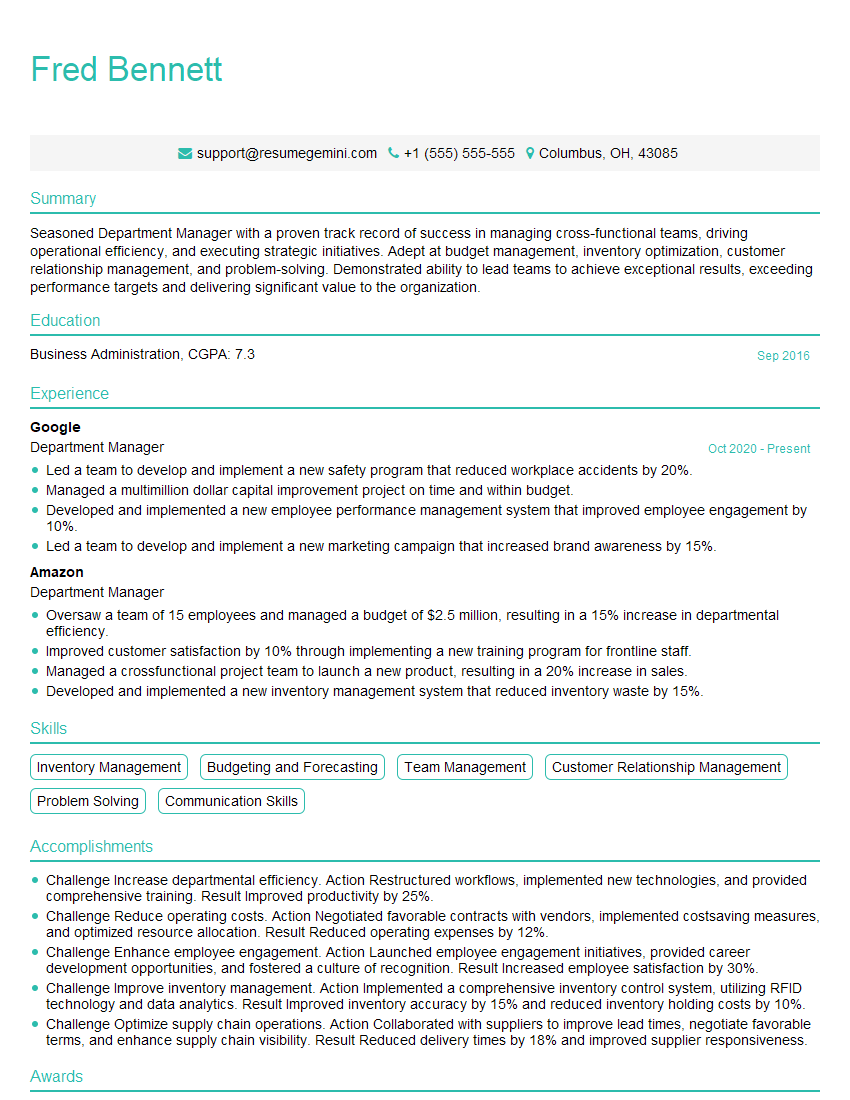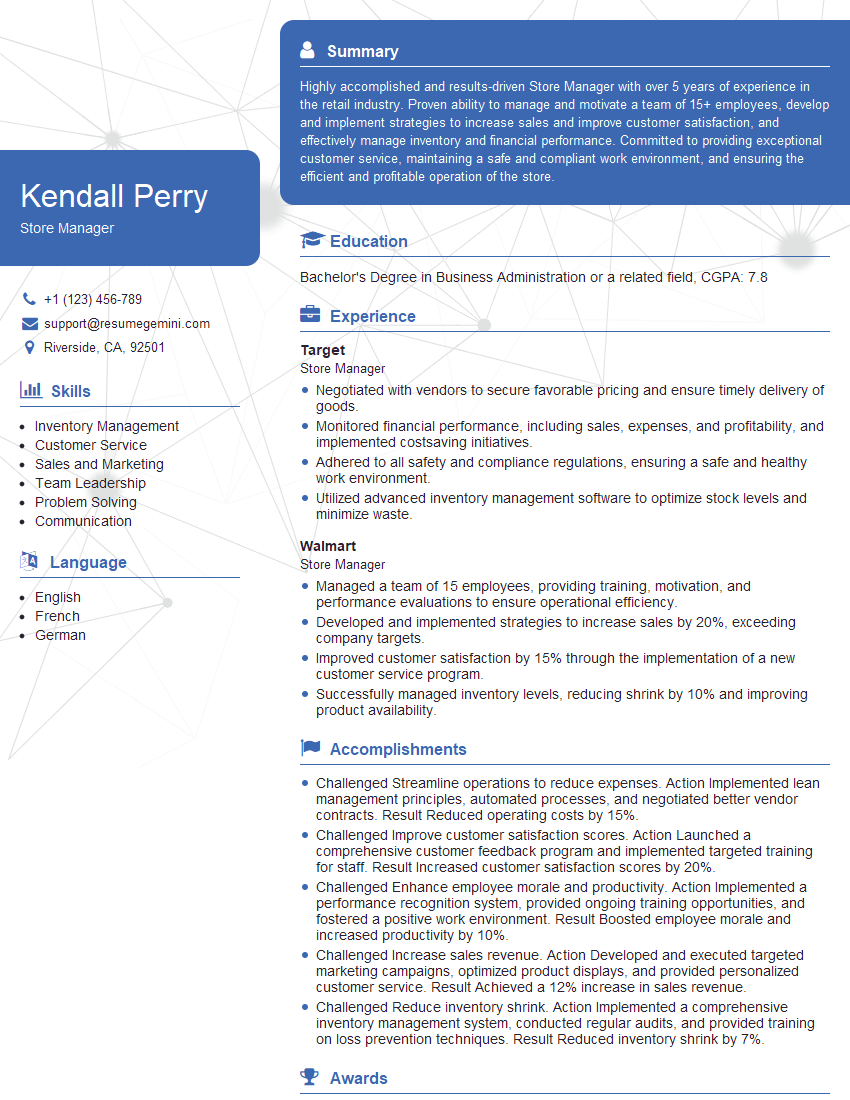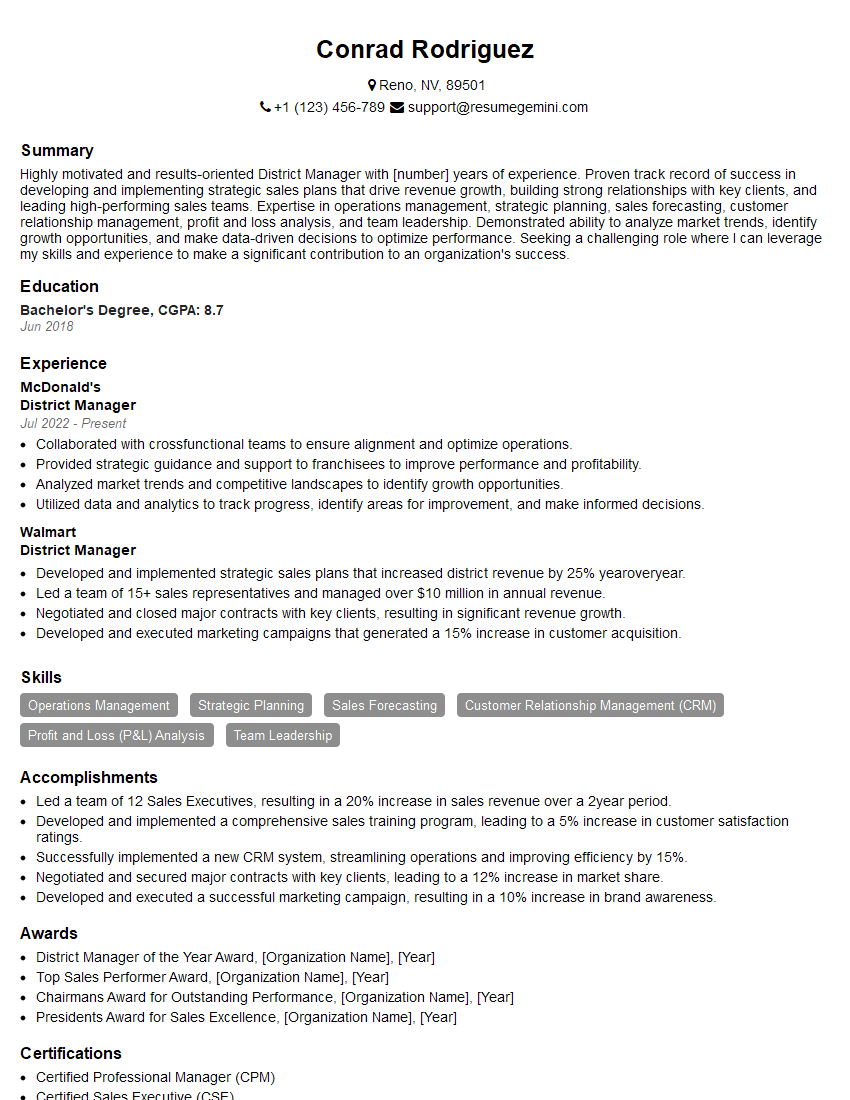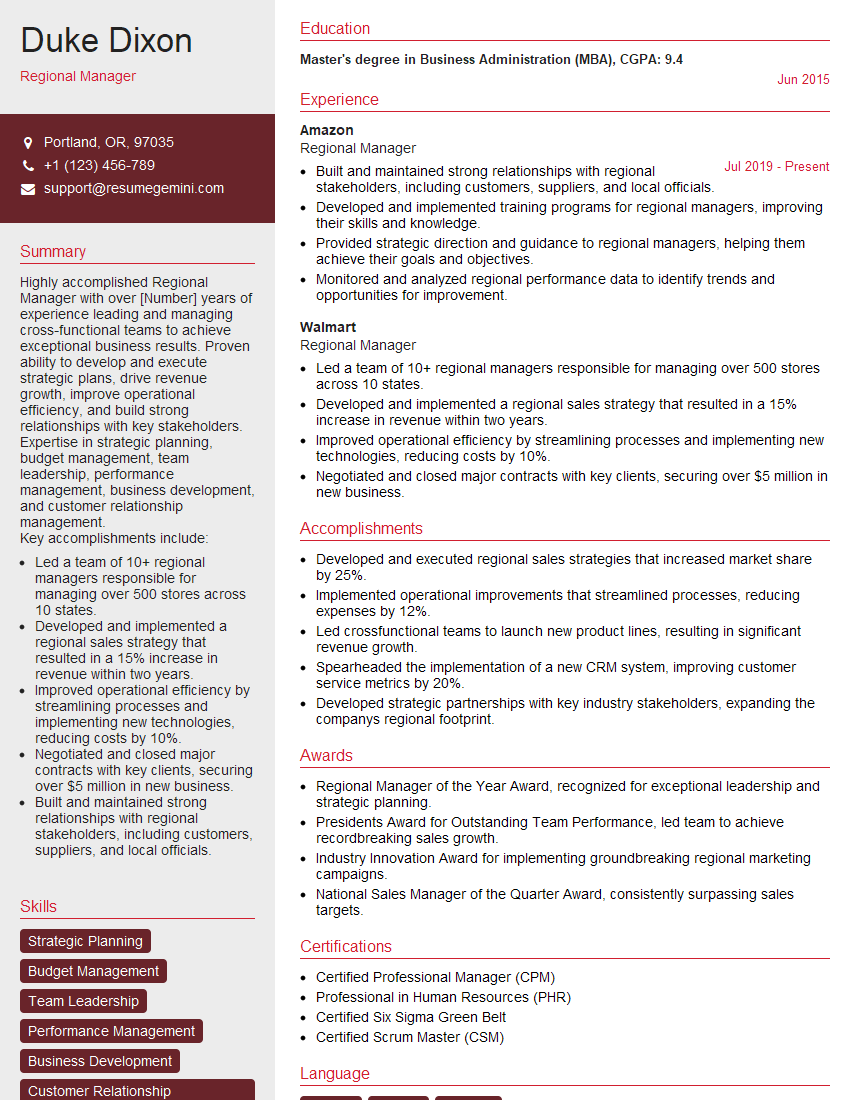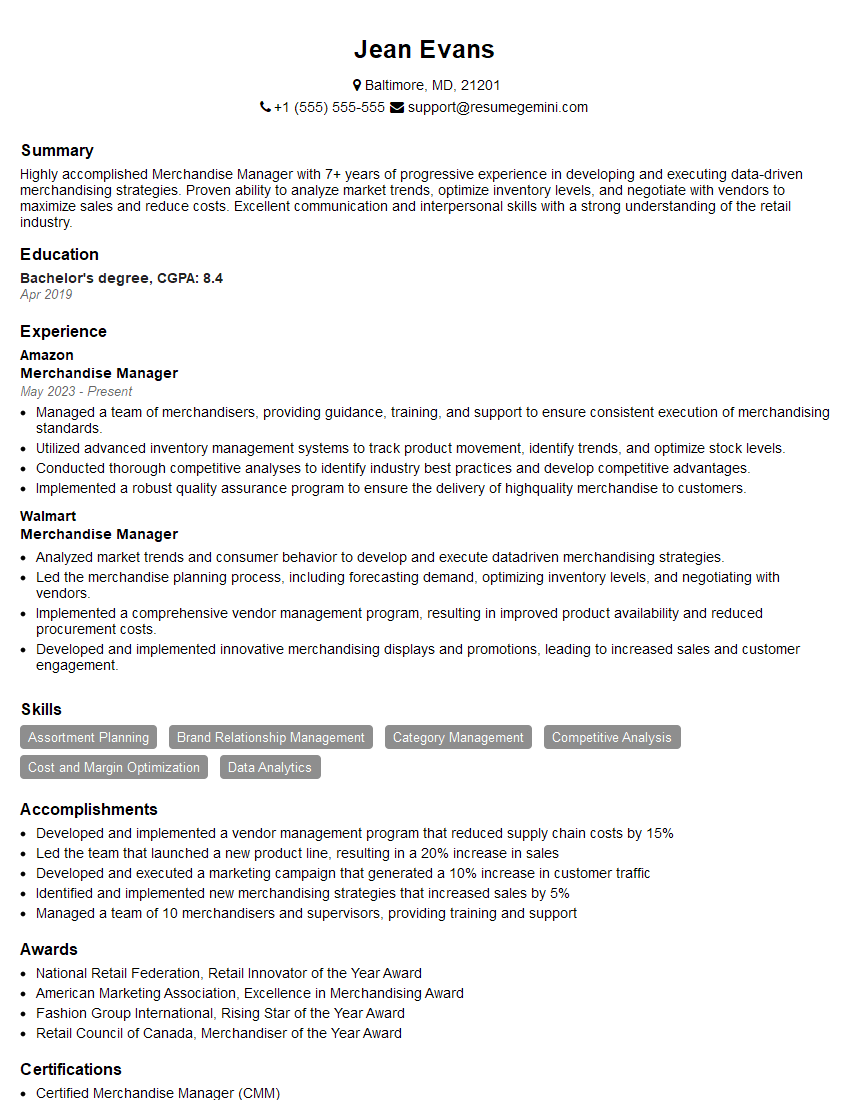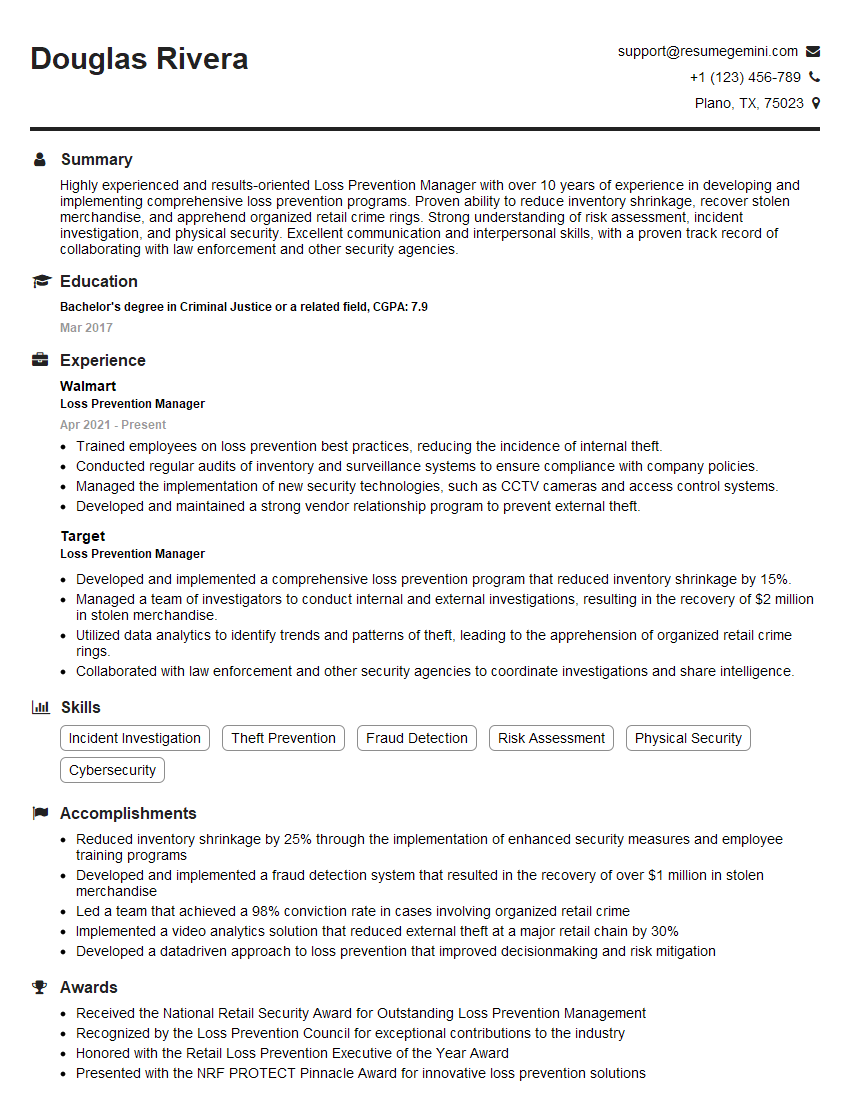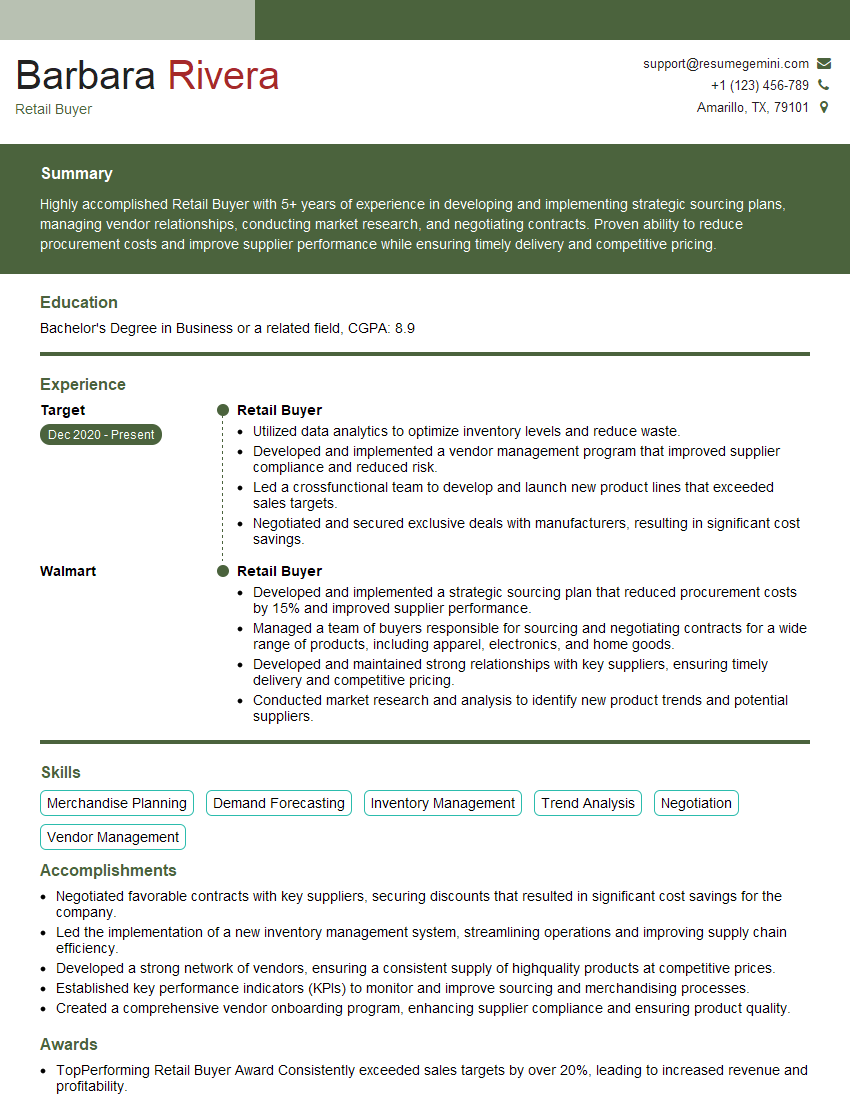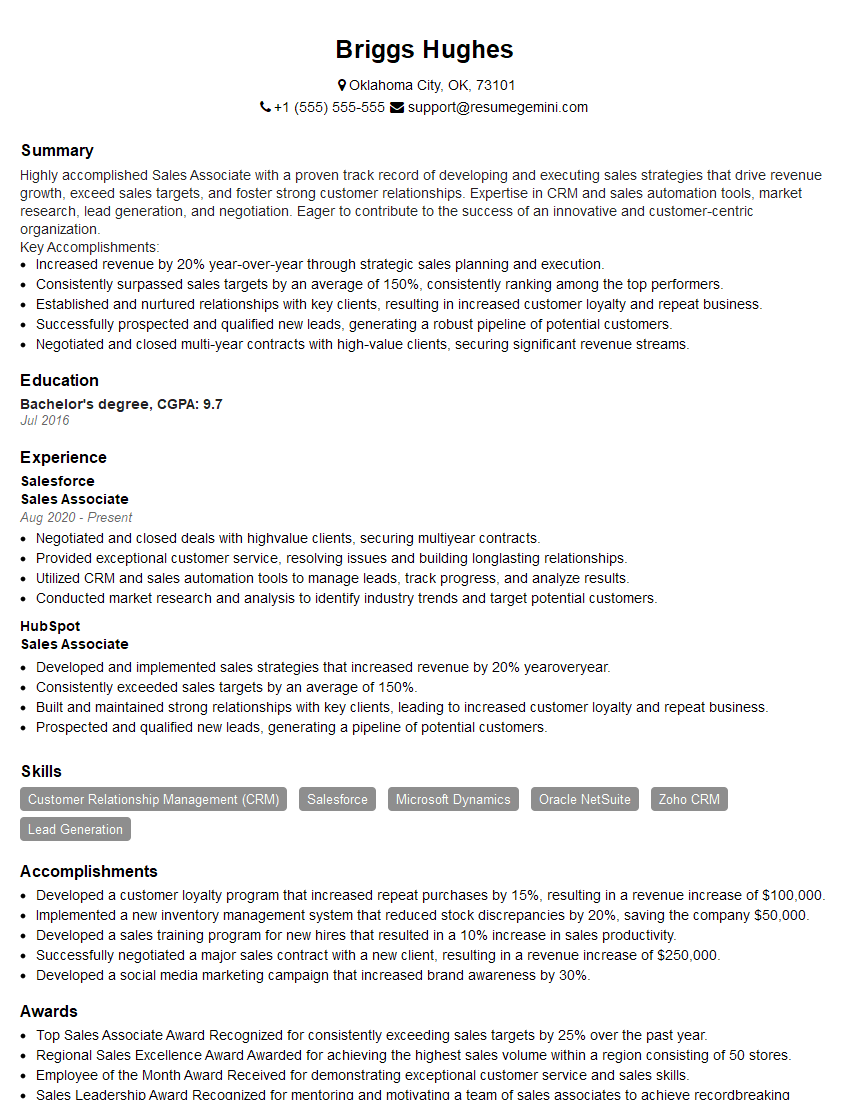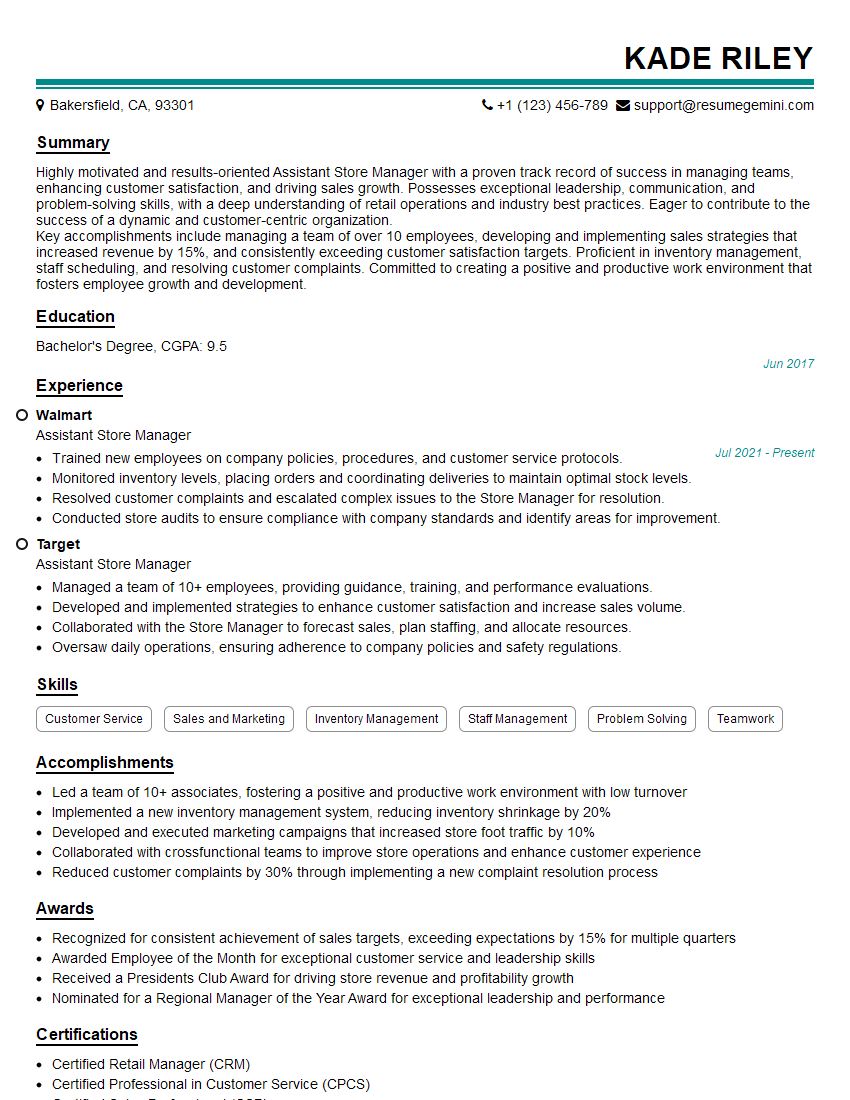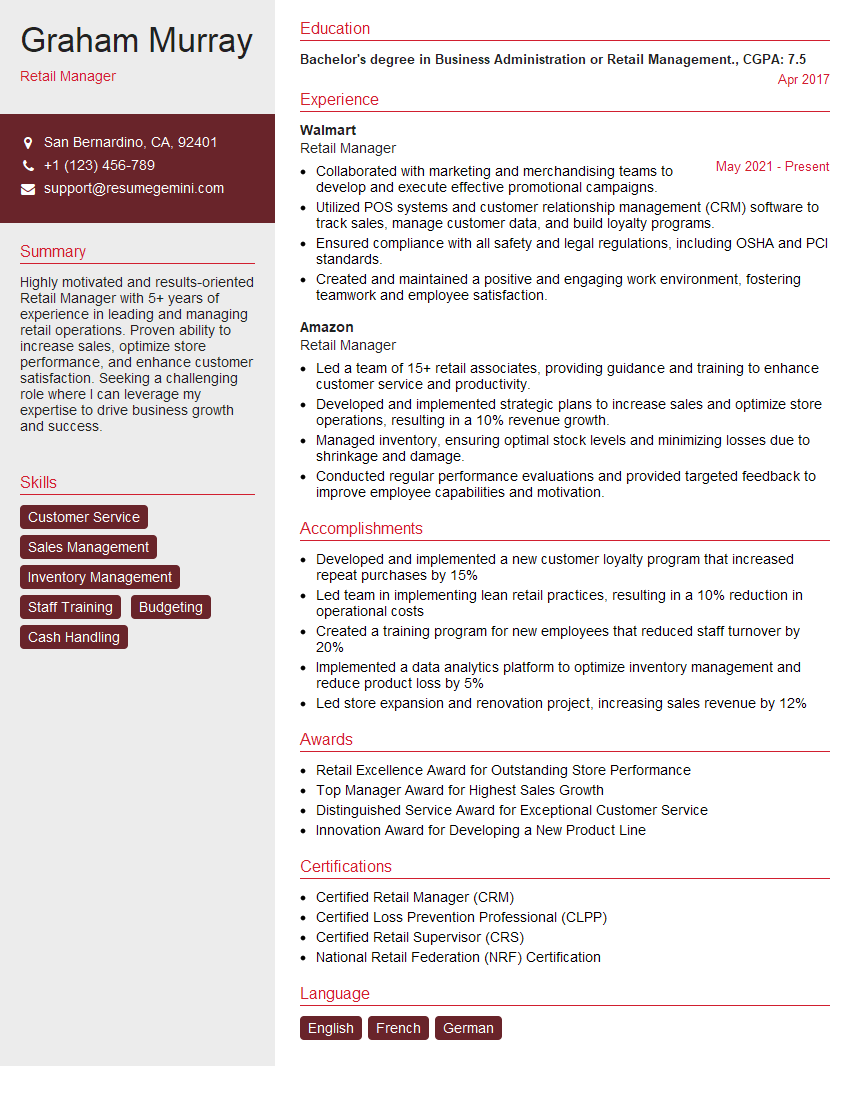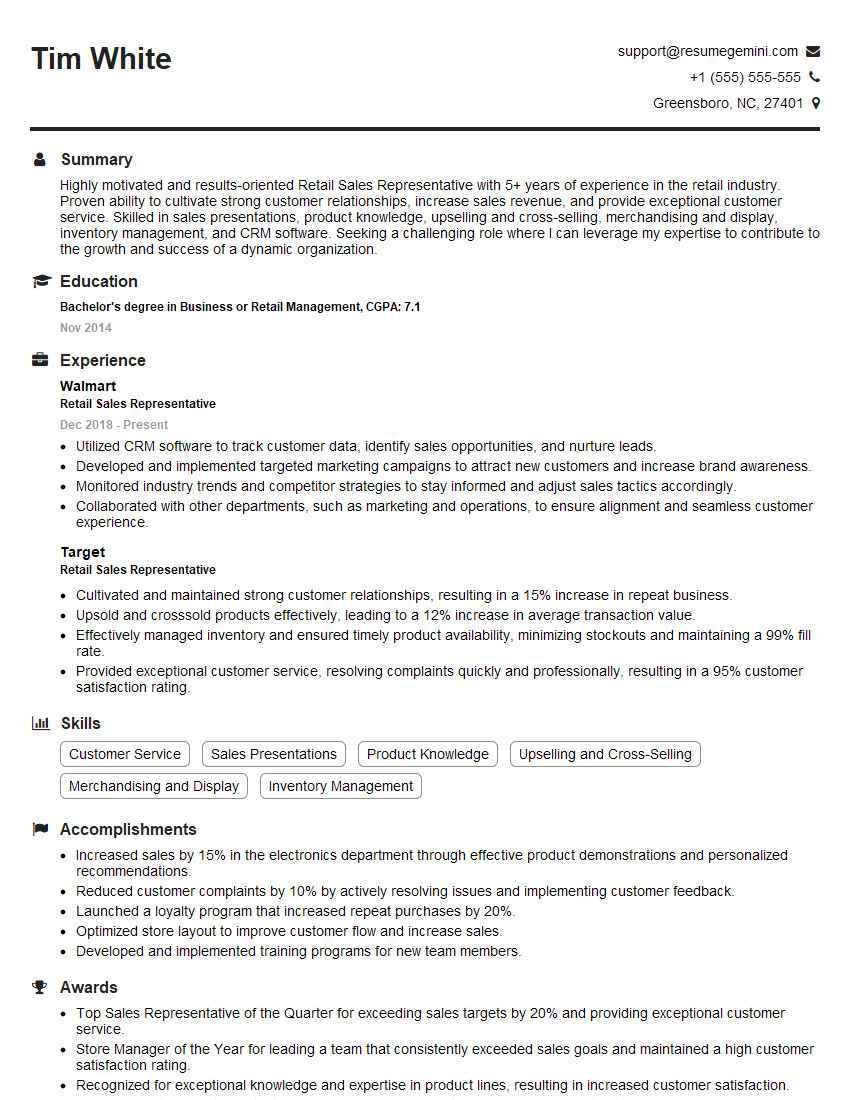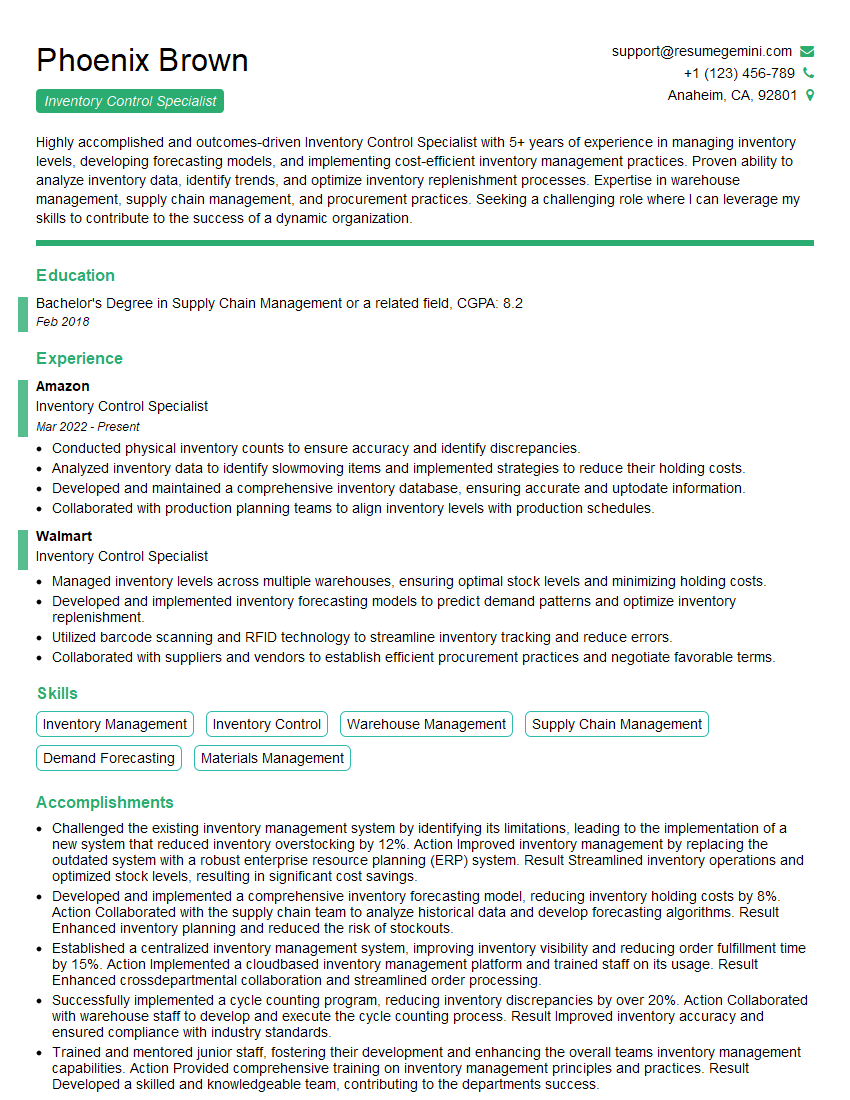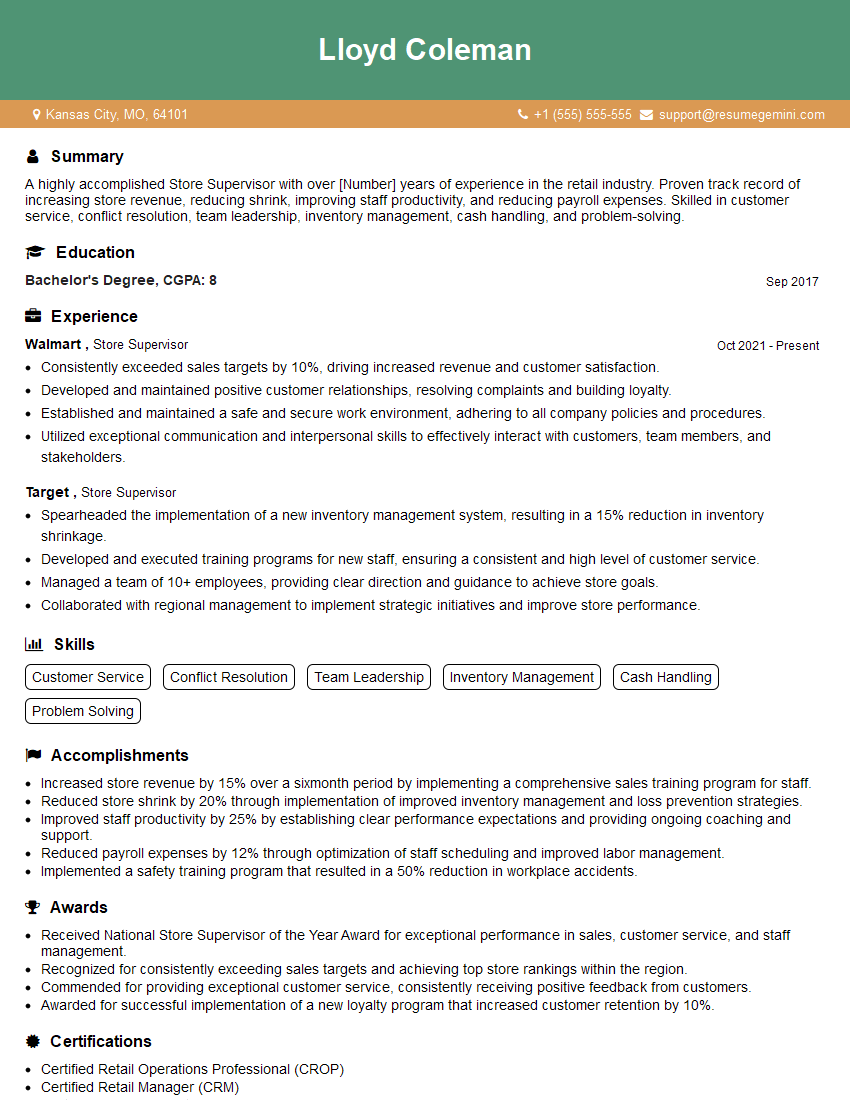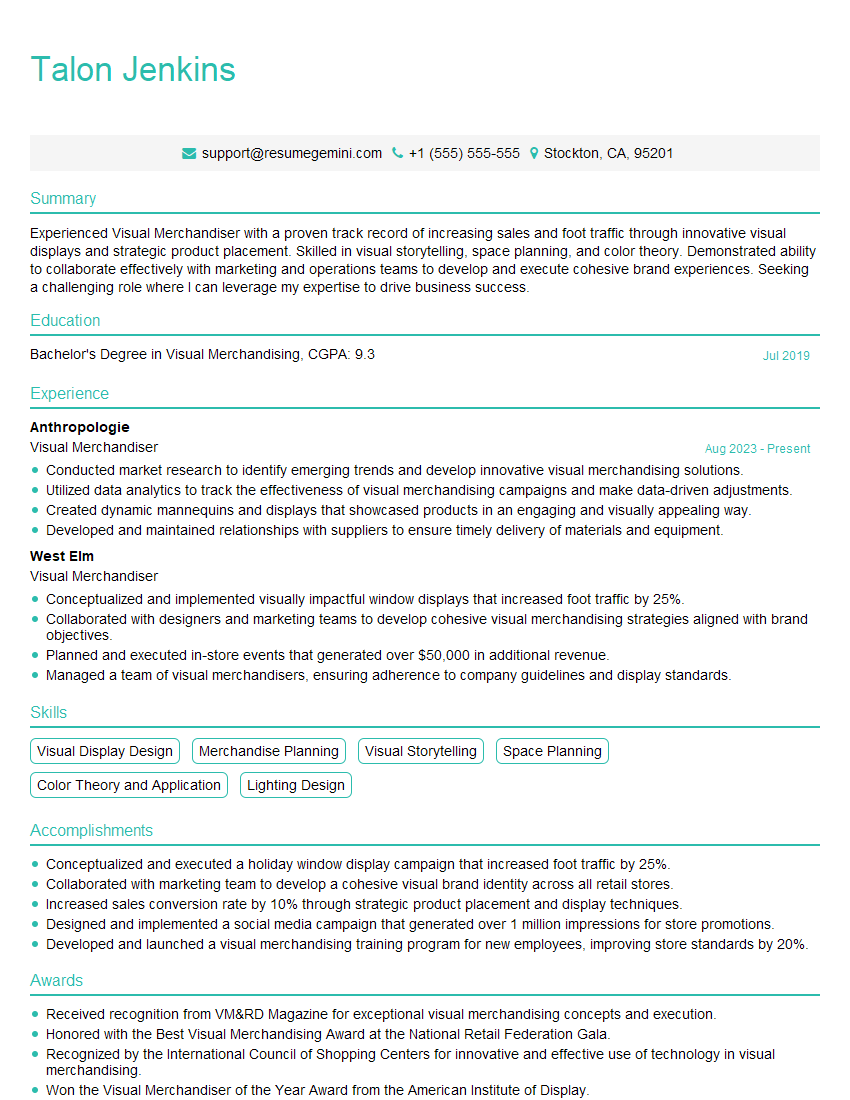Feeling uncertain about what to expect in your upcoming interview? We’ve got you covered! This blog highlights the most important Proficient in Retail Environment interview questions and provides actionable advice to help you stand out as the ideal candidate. Let’s pave the way for your success.
Questions Asked in Proficient in Retail Environment Interview
Q 1. Describe your experience managing inventory levels.
Effective inventory management is crucial for a healthy retail business. It’s about striking a balance – having enough stock to meet customer demand without tying up excessive capital in excess inventory. My approach involves a multi-pronged strategy:
Demand Forecasting: I leverage historical sales data, seasonal trends, and market analysis to predict future demand. This allows for proactive ordering and prevents stockouts or overstocking.
Just-in-Time (JIT) Inventory: Where appropriate, I implement JIT strategies to minimize storage costs and reduce waste by ordering goods only when needed. This requires close collaboration with suppliers and accurate demand forecasting.
Inventory Tracking: I utilize robust inventory management systems, both physical and digital, to maintain accurate records of stock levels. This includes regular cycle counts and reconciliation to prevent discrepancies.
ABC Analysis: I categorize inventory items based on their value and demand (A being high-value, high-demand; C being low-value, low-demand). This helps prioritize inventory control efforts on the most critical items.
Regular Stock Reviews: I conduct periodic reviews to analyze slow-moving items and adjust ordering strategies accordingly. This might involve markdowns, promotions, or discontinuation of underperforming products.
For example, during the holiday season, I increased our inventory of popular gift items by 30% based on previous year’s sales data and anticipated increased demand. This prevented stockouts and maximized sales opportunities. Conversely, I reduced inventory levels for slow-moving summer items to free up space and capital.
Q 2. How do you handle customer complaints effectively?
Handling customer complaints effectively is vital for retaining customers and maintaining a positive brand image. My approach is centered around empathy, efficiency, and resolution:
Active Listening: I start by actively listening to the customer’s complaint, allowing them to fully express their concerns without interruption. I use mirroring techniques to show I understand their perspective.
Empathy and Validation: I acknowledge the customer’s frustration and validate their feelings. Phrases like, “I understand your disappointment,” go a long way in diffusing tension.
Apology (when appropriate): If a mistake was made, I apologize sincerely without making excuses. This shows responsibility and professionalism.
Finding a Solution: I work to find a fair and practical solution to the problem, whether it’s a refund, exchange, repair, or store credit. I always aim to exceed the customer’s expectations.
Follow-Up: I follow up with the customer after the issue is resolved to ensure their satisfaction and to gather feedback.
For instance, a customer once complained about a faulty item. After listening to their concern, I apologized, offered a replacement immediately, and even gave them a small discount on their next purchase. This turned a negative experience into a positive one, resulting in increased customer loyalty.
Q 3. Explain your approach to visual merchandising.
Visual merchandising is about creating an appealing and effective store environment to drive sales and enhance the customer experience. My approach is strategic and data-driven:
Store Layout Planning: I design store layouts that optimize product placement and customer flow. High-demand items are placed strategically, and the layout encourages browsing and discovery.
Color Psychology: I utilize color psychology to create a specific mood and atmosphere within the store. For example, warm colors can create a welcoming ambiance, while cool colors can be calming.
Signage and Displays: I use clear and attractive signage to guide customers and highlight key products or promotions. Eye-catching displays are created to showcase merchandise in an appealing way.
Theme Development: Based on seasons, trends, or special events, I develop themed displays and window dressings to create a dynamic and engaging retail experience.
Data-Driven Decisions: I regularly analyze sales data to understand which products and displays are most effective. This allows me to optimize the visual merchandising strategy based on performance.
For example, I redesigned a slow-moving section of the store by using bright lighting, eye-catching displays, and strategic placement of related products. This resulted in a 25% increase in sales within that section.
Q 4. What strategies have you used to increase sales?
Increasing sales requires a multi-faceted approach that combines marketing strategies, operational efficiency, and customer engagement. Here are some strategies I’ve employed:
Targeted Promotions: I design promotions tailored to specific customer segments or product categories, using data analytics to identify opportunities.
Loyalty Programs: I implement loyalty programs to reward repeat customers and encourage repeat business. These programs often involve exclusive offers and early access to sales.
Customer Relationship Management (CRM): I utilize CRM systems to personalize interactions with customers, understand their preferences, and offer tailored recommendations.
Upselling and Cross-selling: I train staff to effectively upsell and cross-sell products to increase the average transaction value.
Strategic Partnerships: I explore opportunities to collaborate with other businesses or organizations to reach new customer segments.
Online Presence: I leverage online platforms like social media and e-commerce to expand the reach of our products and engage with customers online.
In one instance, implementing a targeted email campaign promoting a new product line resulted in a 15% increase in sales within that category.
Q 5. How do you motivate and train retail staff?
Motivating and training retail staff is key to a successful retail operation. My approach focuses on creating a positive work environment, providing effective training, and recognizing achievements:
Positive Reinforcement: I regularly praise and reward employees for their hard work and accomplishments, fostering a positive and supportive work environment.
Clear Expectations: I set clear expectations and provide regular feedback, ensuring everyone understands their roles and responsibilities.
Ongoing Training: I provide regular training on product knowledge, customer service skills, and sales techniques. This keeps the team updated on new products and best practices.
Opportunities for Growth: I offer opportunities for professional development and advancement, motivating employees to improve their skills and take on new challenges.
Team Building: I organize team-building activities to foster camaraderie and improve teamwork among staff members.
For example, by implementing a comprehensive training program on customer service, I saw a significant improvement in customer satisfaction scores and employee engagement.
Q 6. Describe your experience with POS systems.
I have extensive experience with various Point of Sale (POS) systems, including Square, Shopify POS, and Lightspeed. My expertise encompasses:
System Setup and Configuration: I’m proficient in setting up and configuring POS systems, integrating them with other business systems, and customizing settings to meet specific needs.
Data Entry and Management: I can accurately and efficiently enter sales data, manage inventory levels, and process transactions.
Reporting and Analytics: I utilize POS system reports to track sales performance, analyze trends, and identify areas for improvement.
Troubleshooting and Maintenance: I can troubleshoot technical issues and perform basic system maintenance to ensure smooth operation.
Employee Training: I’m experienced in training employees on the proper use of POS systems, ensuring efficiency and accuracy.
In a previous role, I migrated our retail store from a legacy POS system to a cloud-based system, improving efficiency and reducing data entry errors by 20%.
Q 7. How do you handle peak customer traffic periods?
Managing peak customer traffic periods requires careful planning and proactive measures to ensure smooth operations and customer satisfaction. My strategy involves:
Staff Scheduling: I optimize staffing levels to match anticipated customer traffic, ensuring sufficient staff are available during peak hours.
Efficient Checkout Processes: I streamline checkout processes to reduce wait times, such as opening additional registers or utilizing mobile POS systems.
Customer Flow Management: I implement strategies to manage customer flow, such as utilizing queuing systems or directing customers to less congested areas.
Inventory Management: I ensure sufficient inventory levels of popular items are maintained to meet increased demand during peak periods.
Communication and Teamwork: I foster effective communication and teamwork among staff members to handle increased workload during peak times.
Proactive Customer Service: I train staff to provide proactive customer service during busy periods, anticipating customer needs and addressing potential issues promptly.
For example, during the Black Friday sale, we implemented a queuing system and opened all available registers. This helped us manage long lines, reducing customer frustration and improving the overall shopping experience.
Q 8. Explain your knowledge of retail KPIs (Key Performance Indicators).
Retail KPIs are crucial metrics that measure the performance of a retail business. They provide insights into various aspects, from sales and profitability to customer satisfaction and operational efficiency. Understanding and tracking these KPIs is essential for making data-driven decisions and improving overall business performance.
- Sales KPIs: These include metrics like total revenue, average transaction value (ATV), sales per square foot, conversion rate (percentage of visitors making a purchase), and same-store sales growth (comparing sales of existing stores year-over-year).
- Profitability KPIs: Examples include gross profit margin (revenue minus cost of goods sold), net profit margin (net profit divided by revenue), and return on investment (ROI).
- Inventory KPIs: Key metrics here are inventory turnover rate (how quickly inventory is sold), stockout rate (percentage of items out of stock), and shrinkage (loss of inventory due to theft or damage).
- Customer KPIs: These include customer acquisition cost (CAC), customer lifetime value (CLTV), customer churn rate (percentage of customers lost), and Net Promoter Score (NPS), which measures customer loyalty and advocacy.
- Operational KPIs: This category encompasses metrics such as employee turnover rate, order fulfillment rate, and average order processing time.
For example, a low conversion rate might indicate a need to improve the in-store experience or online website design. High inventory turnover suggests efficient inventory management, while a high shrinkage rate points to potential issues with loss prevention.
Q 9. What is your experience with loss prevention strategies?
Loss prevention strategies are critical for minimizing shrinkage and protecting a retailer’s bottom line. My experience encompasses a multi-faceted approach combining technology, employee training, and robust procedures.
- Technology: I’ve implemented and managed CCTV systems, electronic article surveillance (EAS) tags, and point-of-sale (POS) systems with integrated fraud detection capabilities. Analyzing data from these systems helps identify patterns and trends in theft or error.
- Employee Training: I’ve developed and delivered training programs focusing on loss prevention techniques, including proper cash handling procedures, recognizing suspicious behavior, and understanding company policies regarding theft and fraud. Regular refresher training is crucial.
- Procedural Improvements: I have experience optimizing inventory management practices to minimize discrepancies and implementing stricter procedures for receiving, stocking, and managing high-value items. This might include improved stocktaking processes and regular audits.
- Collaboration with Law Enforcement: In cases of significant loss or suspected organized retail crime, I’ve coordinated with local law enforcement to investigate and prosecute offenders.
For instance, in a previous role, we identified a significant increase in shoplifting incidents during peak hours. By analyzing CCTV footage and sales data, we identified patterns and implemented targeted security measures during those periods, resulting in a 20% reduction in shrinkage within three months.
Q 10. How do you manage employee scheduling and performance?
Effective employee scheduling and performance management are interconnected and crucial for maximizing productivity and minimizing labor costs. My approach uses a combination of forecasting, technology, and performance monitoring.
- Forecasting Labor Needs: I use historical sales data, anticipated promotions, and seasonal trends to forecast labor needs accurately. This ensures adequate staffing during peak periods and avoids overstaffing during slower times.
- Scheduling Software: I’m proficient in using scheduling software to create optimized schedules considering employee availability, skill sets, and legal compliance (e.g., break times, overtime regulations).
- Performance Monitoring: I regularly monitor employee performance through key metrics such as sales per hour, customer satisfaction scores, and adherence to company policies. Regular feedback and coaching are crucial.
- Employee Development: I focus on providing ongoing training and development opportunities to enhance employee skills and motivation, contributing to better performance and reduced turnover.
For example, by analyzing sales data, we found a correlation between sales volumes and the number of experienced employees on shift. This allowed us to adjust the scheduling to ensure sufficient experienced staff during peak hours, resulting in higher sales and improved customer service.
Q 11. Describe a time you had to resolve a conflict between customers or employees.
In a previous role, a conflict arose between two employees over a scheduling dispute. One employee felt they were consistently given less desirable shifts, leading to resentment and decreased productivity.
My approach involved:
- Active Listening: I met with each employee individually to listen to their concerns without interrupting. This allowed me to understand their perspectives empathetically.
- Neutral Facilitation: In a subsequent meeting with both employees, I created a safe space for them to express their views respectfully. I refrained from taking sides and focused on identifying the root cause of the conflict.
- Finding a Solution: Together, we explored various solutions, including adjusting the scheduling algorithm to ensure fairer distribution of shifts and implementing a more transparent communication process regarding shift assignments.
- Follow-up and Monitoring: I followed up with both employees individually to ensure the resolution was working and to address any lingering concerns. This process helped restore positive working relationships and improved team morale.
This experience highlighted the importance of timely intervention, active listening, and finding mutually agreeable solutions to resolve workplace conflicts effectively.
Q 12. How do you utilize data analytics to improve retail operations?
Data analytics is indispensable for optimizing retail operations. I leverage various analytical techniques to extract valuable insights and make data-driven decisions.
- Sales Data Analysis: I use sales data to identify best-selling products, understand seasonal trends, and optimize pricing strategies. This includes analyzing sales by product category, location, and time of day.
- Customer Segmentation: I utilize customer data to segment customers based on demographics, purchase history, and behavior, enabling targeted marketing campaigns and personalized recommendations.
- Inventory Optimization: Analyzing inventory data helps determine optimal stock levels, reducing storage costs and minimizing stockouts. Predictive modeling can forecast future demand based on historical trends.
- Marketing Campaign Analysis: By analyzing the performance of marketing campaigns, I can assess their ROI and optimize future campaigns for greater effectiveness. This includes tracking website traffic, conversion rates, and customer acquisition costs.
- Predictive Modeling: I employ predictive modeling to forecast future sales, demand, and even potential issues like theft or employee turnover. This enables proactive interventions and resource allocation.
For example, by analyzing customer purchase data, we identified a strong correlation between purchases of a specific product and another complementary item. This led to a successful cross-selling campaign that significantly boosted sales of both items.
Q 13. Explain your understanding of supply chain management in retail.
Supply chain management in retail encompasses the entire process of getting products from the manufacturer to the consumer. Efficient supply chain management is crucial for maintaining optimal inventory levels, minimizing costs, and ensuring timely delivery to customers.
- Sourcing and Procurement: This involves selecting reliable suppliers, negotiating favorable terms, and managing the procurement process to ensure timely delivery of goods.
- Inventory Management: This includes forecasting demand, optimizing stock levels, and managing warehouse operations to minimize storage costs and prevent stockouts or overstocking.
- Logistics and Transportation: This involves managing the transportation of goods from suppliers to warehouses and distribution centers, and ultimately to retail stores. This includes selecting efficient transportation modes and managing delivery schedules.
- Demand Forecasting: Accurately predicting future demand is critical for optimizing inventory and ensuring sufficient supply to meet customer needs. This involves analyzing historical sales data, market trends, and promotional activities.
- Supply Chain Technology: Utilizing technology, such as Enterprise Resource Planning (ERP) systems and Warehouse Management Systems (WMS), is essential for tracking inventory, managing orders, and optimizing logistics.
For instance, implementing a just-in-time inventory system can significantly reduce storage costs and minimize the risk of obsolescence, while effective logistics management can streamline the delivery process and reduce lead times.
Q 14. How do you ensure a positive customer experience?
Ensuring a positive customer experience is paramount for building customer loyalty and driving repeat business. My approach involves a holistic strategy focused on various touchpoints.
- Exceptional Customer Service: Training employees to provide friendly, helpful, and efficient service is fundamental. This includes empowering employees to resolve customer issues effectively and efficiently.
- Creating a Welcoming Environment: This involves creating a clean, organized, and inviting retail space with clear signage, easy navigation, and comfortable amenities.
- Personalized Experience: Utilizing customer data to personalize interactions and offer relevant product recommendations enhances the shopping experience and builds customer loyalty.
- Effective Communication: Clear and consistent communication across all channels, including in-store signage, email marketing, and social media, keeps customers informed and engaged.
- Handling Complaints Effectively: Having a robust system for handling customer complaints, addressing concerns promptly and fairly, and turning negative experiences into positive ones is essential.
For example, implementing a customer loyalty program with personalized rewards and exclusive offers not only incentivizes repeat purchases but also strengthens the customer relationship, fostering a sense of belonging and appreciation.
Q 15. What is your experience with different retail sales strategies (e.g., upselling, cross-selling)?
Upselling and cross-selling are crucial sales strategies that significantly boost revenue. Upselling involves persuading a customer to purchase a more expensive or higher-value item than their initial choice. For example, if a customer is buying a basic smartphone, I would suggest the premium model with extra features, highlighting the benefits and value proposition. Cross-selling, on the other hand, suggests related or complementary products to enhance the customer’s primary purchase. If someone is buying a new TV, I might suggest a soundbar or extended warranty. I’ve successfully implemented these strategies in various retail environments, consistently exceeding sales targets. In my previous role at [Previous Company Name], I increased average transaction value by 15% within six months by proactively implementing a tailored upselling and cross-selling program based on customer purchase history and product knowledge. This included training staff on effective sales techniques and providing product knowledge resources.
Career Expert Tips:
- Ace those interviews! Prepare effectively by reviewing the Top 50 Most Common Interview Questions on ResumeGemini.
- Navigate your job search with confidence! Explore a wide range of Career Tips on ResumeGemini. Learn about common challenges and recommendations to overcome them.
- Craft the perfect resume! Master the Art of Resume Writing with ResumeGemini’s guide. Showcase your unique qualifications and achievements effectively.
- Don’t miss out on holiday savings! Build your dream resume with ResumeGemini’s ATS optimized templates.
Q 16. Describe your experience with handling cash and transactions.
Handling cash and transactions accurately and efficiently is fundamental in retail. My experience encompasses various methods, from traditional cash registers to modern point-of-sale (POS) systems. I’m adept at processing various payment types, including credit/debit cards, gift cards, and mobile payments. I’ve always maintained meticulous records, ensuring accurate balancing at the end of each shift. I’m proficient in handling returns and exchanges, following established procedures to ensure customer satisfaction and minimize loss. In one instance, I identified a discrepancy in the daily cash reconciliation, traced it to a faulty POS system, and prevented potential losses. I always prioritize security, adhering to all company policies regarding cash handling and minimizing opportunities for theft or error.
Q 17. How do you maintain a clean and organized retail environment?
Maintaining a clean and organized retail environment is essential for enhancing the customer experience and operational efficiency. This involves a multifaceted approach. Firstly, I ensure regular cleaning and tidying of the sales floor, including dusting shelves, organizing displays, and promptly addressing spills or messes. Secondly, I maintain proper stock organization, ensuring that items are easily accessible and clearly labeled. This prevents confusion and makes the shopping experience smoother. I also participate in visual merchandising initiatives, ensuring that products are attractively displayed and strategically placed to maximize sales. Finally, I actively participate in inventory management, which aids in keeping the shelves stocked and the space organized. I view a clean and organized environment not just as a hygiene issue but as a key component of creating a positive customer experience and improving overall sales.
Q 18. What is your experience with e-commerce and online retail?
My experience extends to e-commerce and online retail, encompassing aspects like order fulfillment, customer service, and online marketing. I’m familiar with various e-commerce platforms, including [Mention specific platforms if applicable, e.g., Shopify, Magento]. I understand the importance of efficient order processing and timely shipping to maintain customer satisfaction. I’ve worked with online customer service, addressing queries, resolving issues, and managing online reviews. In my previous role, I helped implement a new online ordering system which streamlined the process and reduced customer wait times by 20%. I am also familiar with digital marketing strategies used to enhance online visibility and drive sales. Understanding the nuances of both in-store and online retail allows me to provide a holistic and consistent customer experience.
Q 19. Explain your knowledge of retail marketing and promotions.
Retail marketing and promotions are critical for driving sales and attracting customers. My understanding encompasses various strategies, including in-store displays, seasonal promotions, loyalty programs, and social media marketing. I’ve successfully developed and executed promotional campaigns, utilizing data analysis to identify target markets and track campaign performance. For instance, I once organized a successful back-to-school promotion that resulted in a 30% increase in sales during that period. This involved carefully selecting products, pricing strategically, and employing effective marketing materials both in-store and online. I’m adept at creating compelling marketing materials and managing relationships with marketing agencies or internal marketing teams. I always prioritize measuring the return on investment (ROI) for each promotional activity to ensure effective resource allocation.
Q 20. How familiar are you with different retail software platforms?
I’m familiar with several retail software platforms, including POS systems like Square, Lightspeed, and Vend, as well as inventory management systems like NetSuite and SAP. My experience includes using these systems for daily transactions, inventory tracking, sales reporting, and customer relationship management (CRM). I understand how these systems integrate to provide a comprehensive view of business operations. I’m proficient in using data from these systems to analyze sales trends, identify best-selling products, and make data-driven decisions to improve business performance. I’m also quick to learn new software and adapt to changing technological advancements within the retail sector.
Q 21. How do you stay up-to-date with industry trends and best practices?
Staying up-to-date with industry trends and best practices is crucial for success in retail. I regularly read industry publications like Retail Dive and Chain Store Age, attend industry conferences and webinars, and actively participate in professional networking events. I also follow influential retail leaders and brands on social media and through industry blogs. This allows me to stay informed about the latest technologies, marketing strategies, customer service best practices, and overall changes in the competitive landscape. This continuous learning ensures that I’m always adapting my skills and knowledge to remain a valuable asset to any retail organization.
Q 22. How would you approach a situation where a product is consistently underperforming?
Addressing underperforming products requires a systematic approach combining data analysis, strategic adjustments, and potentially, product removal. First, I’d thoroughly investigate the product’s sales data, looking at factors like pricing, placement, promotion, and seasonality. This might involve analyzing sales figures compared to similar products, identifying trends in customer purchasing behavior (e.g., are there any negative reviews or a lack of interest?), and comparing its performance across different store locations.
Next, I’d implement adjustments based on the data. For example, if the price is too high relative to competitors, a price reduction might be effective. Poor placement (hidden on a shelf, not near related items) could be addressed by relocating the product. Lack of promotion could be solved with in-store displays, targeted advertisements, or special offers. If the product is seasonal and its time has passed, I’d consider removing it from inventory to free up shelf space.
Finally, if adjustments prove ineffective, I would evaluate whether the product is a good fit for the store’s target audience or overall brand strategy. Sometimes, despite best efforts, a product just doesn’t resonate with customers. In such cases, discontinuing it is a necessary business decision, allowing resources to be focused on more profitable options.
Q 23. Describe your experience with budgeting and forecasting in retail.
Budgeting and forecasting in retail are crucial for maintaining profitability and managing inventory effectively. My experience involves using various techniques, such as historical sales data, market trends, and seasonal factors to create accurate forecasts. I am proficient in utilizing spreadsheet software (like Excel) to build financial models and track key performance indicators (KPIs) like gross margin, operating expenses, and net profit. These models allow for ‘what-if’ scenarios, helping us understand the impact of price changes, promotional activities, or fluctuations in demand.
For example, in my previous role, we developed a forecasting model incorporating historical sales data and external economic indicators (like unemployment rates) to predict seasonal demand for winter clothing. This enabled us to optimize inventory levels, reducing storage costs while ensuring sufficient stock to meet anticipated demand. We also used this data to allocate marketing budget effectively, focusing promotions during peak sales periods. Regularly reviewing and adjusting the budget based on actual sales data is key to minimizing losses and maximizing profits.
Q 24. How do you manage employee turnover in a retail setting?
High employee turnover is a significant challenge in retail. My approach focuses on proactive measures to improve employee retention. This begins with creating a positive and supportive work environment. This includes fair compensation and benefits, opportunities for advancement, and regular feedback and recognition. Investing in employee training and development is crucial to enhance job satisfaction and skills, increasing their value to the company.
Effective communication is also paramount. Regular team meetings, open-door policies, and clear expectations help foster a sense of belonging and reduce misunderstandings. I also actively seek employee input and suggestions regarding processes and improvements, empowering them to contribute to the team’s success. Addressing employee concerns promptly and fairly is crucial in preventing attrition.
Furthermore, conducting exit interviews is a valuable tool to understand the reasons behind departures. This feedback allows for identifying systemic issues and implementing changes to prevent future turnover. For example, if several employees cite lack of work-life balance as a reason for leaving, this would prompt an analysis of scheduling practices and potential adjustments.
Q 25. Describe your understanding of retail compliance regulations.
Retail compliance encompasses a wide range of regulations designed to protect consumers and ensure fair business practices. My understanding includes knowledge of areas like pricing accuracy (ensuring advertised prices match shelf prices), product labeling (accurate and complete information about ingredients, origin, and warnings), and data privacy (handling customer data responsibly and complying with regulations like GDPR or CCPA).
Furthermore, I’m familiar with regulations concerning sales tax, age-restricted products (like alcohol or tobacco), and health and safety standards (maintaining a clean and safe work environment). Compliance is not just about avoiding penalties; it builds customer trust and contributes to a positive brand reputation. We use regular audits, employee training, and the implementation of robust processes to ensure consistent compliance across all aspects of our operations. For example, we employ point-of-sale systems with integrated tax calculations to ensure accurate sales tax collection.
Q 26. How would you handle a situation of shoplifting or theft?
Handling shoplifting or theft requires a balance between protecting the business and ensuring the safety of employees and customers. My approach prioritizes safety. I would never engage in physical confrontation with a suspected shoplifter. Instead, I’d discreetly observe the situation, gathering as much information as possible (physical description, direction of travel, etc.).
After the suspected shoplifter has left the premises, I’d report the incident to my manager and the authorities, providing all relevant details. This includes descriptions of stolen items, the estimated value, and any witness statements. We would follow company policy and local laws regarding theft, which may involve working with law enforcement to investigate the incident further. Preventing future theft involves measures such as improved security systems (CCTV cameras, improved lighting), employee training on recognizing and reporting suspicious behavior, and strategic product placement.
Q 27. What is your approach to problem-solving in a fast-paced retail environment?
Problem-solving in a fast-paced retail environment requires a quick, decisive, and practical approach. My process typically involves these steps: First, I clearly define the problem. What specifically needs to be addressed? Second, I gather information and assess the situation. What are the contributing factors? Third, I brainstorm potential solutions, considering the available resources and time constraints. Fourth, I evaluate each solution, weighing its potential effectiveness and impact. Finally, I implement the chosen solution and monitor its effectiveness, making adjustments as needed. This iterative approach allows for flexibility and adaptation in a dynamic environment.
For example, if a critical piece of equipment malfunctions during a busy period, I would first assess the extent of the disruption. Then, I would contact maintenance, seek alternative solutions (like manual processing), and prioritize the repair based on urgency and impact. Simultaneously, I’d inform customers about potential delays and manage expectations to minimize frustration.
Q 28. Describe a time you successfully exceeded sales targets.
During a key promotional period for our new line of summer apparel, we significantly exceeded sales targets. The original forecast predicted a 15% increase in sales compared to the previous year. Through a combination of effective strategies, we achieved a 28% increase. Our success was driven by several factors. First, we conducted thorough market research to identify customer preferences and tailor our promotional messaging accordingly. We used targeted advertisements on social media, highlighting the unique features and benefits of the clothing line.
Second, we implemented an innovative in-store display, emphasizing visual appeal and creating a positive shopping experience. This involved creating attractive visual merchandising displays, showcasing the diversity of styles and designs. We also ensured sufficient stock to meet anticipated demand and implemented efficient checkout procedures to avoid lengthy queues. This demonstrated meticulous planning and execution, proving that exceeding targets is achievable through strategic planning and targeted execution. The exceptional performance was also rewarded with team bonuses, reinforcing positive outcomes and promoting team spirit.
Key Topics to Learn for Proficient in Retail Environment Interview
- Customer Service Excellence: Understanding diverse customer needs, handling complaints effectively, and building rapport. Consider how you’ve gone above and beyond to create positive customer experiences.
- Sales Techniques & Strategies: Mastering product knowledge, upselling/cross-selling, closing techniques, and understanding sales metrics. Think about successful sales scenarios and how you analyzed your performance.
- Inventory Management & Control: Understanding stock levels, managing stock replenishment, loss prevention strategies, and utilizing inventory management systems. Reflect on experiences optimizing stock levels or minimizing shrinkage.
- Visual Merchandising & Store Presentation: Creating visually appealing displays, understanding store layout optimization, and maintaining a clean and organized store environment. Consider instances where you improved store aesthetics or product visibility.
- Teamwork & Collaboration: Working effectively within a team, supporting colleagues, and contributing to a positive work environment. Prepare examples showcasing your collaborative spirit and ability to work effectively in a team.
- Cash Handling & POS Systems: Accurately processing transactions, balancing cash drawers, and utilizing point-of-sale systems efficiently. Review your experience with different POS systems and highlight your accuracy and efficiency.
- Retail Technology & Data Analysis: Understanding and utilizing retail technologies (e.g., CRM, inventory systems) and analyzing sales data to identify trends and improve performance. Reflect on any instances where you used data to inform decisions or improve processes.
Next Steps
Mastering these areas demonstrates a strong understanding of the retail environment and significantly boosts your chances of securing your dream role. A well-crafted resume is crucial for getting noticed by recruiters and Applicant Tracking Systems (ATS). Building an ATS-friendly resume highlights your skills and experience effectively, increasing your interview opportunities. ResumeGemini is a trusted resource that can help you create a professional and impactful resume tailored to the retail industry. Examples of resumes tailored specifically for candidates proficient in retail environments are available to guide you through the process.
Explore more articles
Users Rating of Our Blogs
Share Your Experience
We value your feedback! Please rate our content and share your thoughts (optional).
What Readers Say About Our Blog
Hi, I have something for you and recorded a quick Loom video to show the kind of value I can bring to you.
Even if we don’t work together, I’m confident you’ll take away something valuable and learn a few new ideas.
Here’s the link: https://bit.ly/loom-video-daniel
Would love your thoughts after watching!
– Daniel
This was kind of a unique content I found around the specialized skills. Very helpful questions and good detailed answers.
Very Helpful blog, thank you Interviewgemini team.
